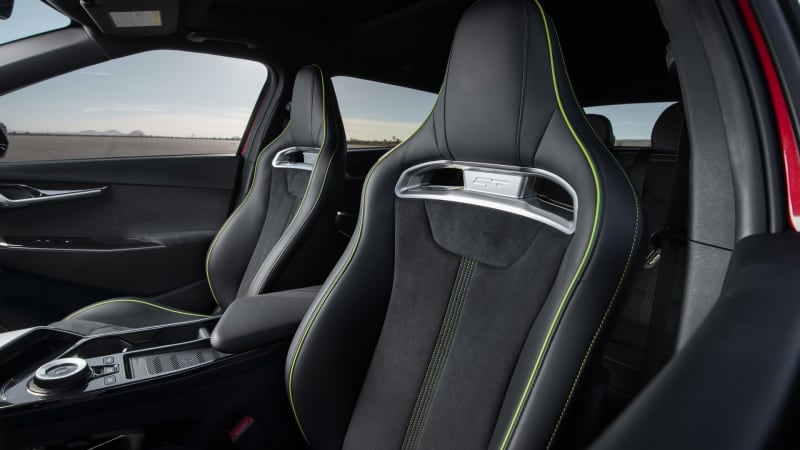LAS VEGAS – This is the E-GMP car we’ve been waiting for. As great as the Hyundai Group triplets of Kia EV6, Hyundai Ioniq 5 and Genesis GV60 are, we’ve always known that something greater (and far more powerful) was lurking in future: this 576-horsepower 2023 Kia EV6 GT. Despite impressing with their state-of-the-art EV architecture, unique designs, distinctive interiors and compelling value, none of them could be described as fun in the traditional sense. They’re heavy, a bit soft and sit kind of high. So, now that the EV6 GT is finally here, does it actually deliver that missing ingredient?
If it does, it will do so stealthily, as the GT is nearly impossible to tell apart from just another GT-Line car (you can see how that visually differs from the base Wind trim level here). The body is identical save for slightly different grille inserts and rear diffuser panel. It does get 21-inch wheels and lime-green brake calipers, which are monoblock units grasping larger rotors (15-inch front, 14.2-inch rear). The interior is similarly, well, similar to GT-Line, though it now has lime green accents and “GT” badges. The steering wheel also has a big green button labeled “GT,” which selects its most hardcore drive mode. We’ll get into that in a minute.
The main difference is the addition of sporty bucket seats, and they’re a massive improvement over the standard EV6 seats in terms of overall support. Big strong bolsters hug you, but not so tight to be unpleasant for those of bigger builds (I’m approximately 300 pounds for reference). They have deeper lower sections that provide better thigh support. They’re heated, too, but unfortunately, they’re also only manually adjustable. This is a bummer for a car that costs more than $60,000 and for a range-topping Kia, a company that prides itself on stuffing its cars with features for reasonable prices. While I might happily trade power controls for better-shaped seats as I would in a Mustang or Porsche, how many will be irked that their range-topping Kia EV6 lacks a common feature found on a $23,000 Soul?
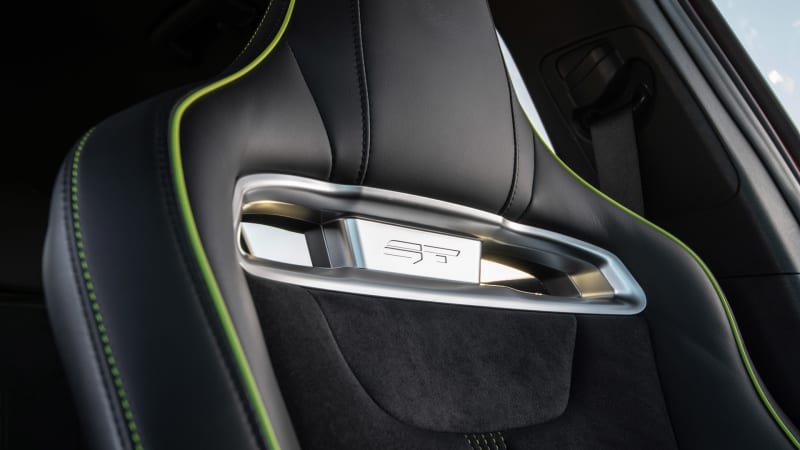
Things are much different under the skin, though, and the obvious change is in the GT’s powertrain. Both motors are more potent than those in the regular all-wheel-drive EV6s at 215 horsepower for the front and 362 at the rear. Combined they make 576 hp and 545 pound-feet of torque – increases of 256 hp and 99 lb-ft. Kia also claims these motors will propel the 4,795-pound EV6 GT to 60 mph in 3.4 seconds with a top speed of 161 mph. We didn’t get it going that fast, but we did have the opportunity to run it on a drag strip at Las Vegas Motor Speedway, managing an 11.7-second quarter-mile time with a trap speed of 117. Numbers aside, you can really feel the added power. It’ll pin you hard, and it feels strong all the way through highway speeds, only starting to taper slightly past 100 mph.
Interestingly, Kia noted during the press launch that peak power starts to dip below the 70% charge mark, but did not indicate by how much. We did have some time to drive the cars with full charges as well as partially depleted on the street and, at least in that real-world environment, could not detect a loss in power. But if you’re planning on tracking a GT or doing some other high-performance driving, you’ll probably want to make sure you charge it to the brim, and then go easy on the way to the track.
Naturally, the chassis has been tweaked to meet the GT’s overall performance intent. It features stiffer springs, additional front and rear reinforcements, and electronically adjustable shocks. The rear motor is also connected to an electronically-controlled mechanical limited-slip differential. It’s all adjustable via various drive modes, which have expanded from Eco, Normal and Sport to include GT and a user-customizable mode. Beyond the usual throttle calibration and steering weight, they adjust the actual power output, torque split, suspension firmness, traction and stability control and limited-slip differential function.
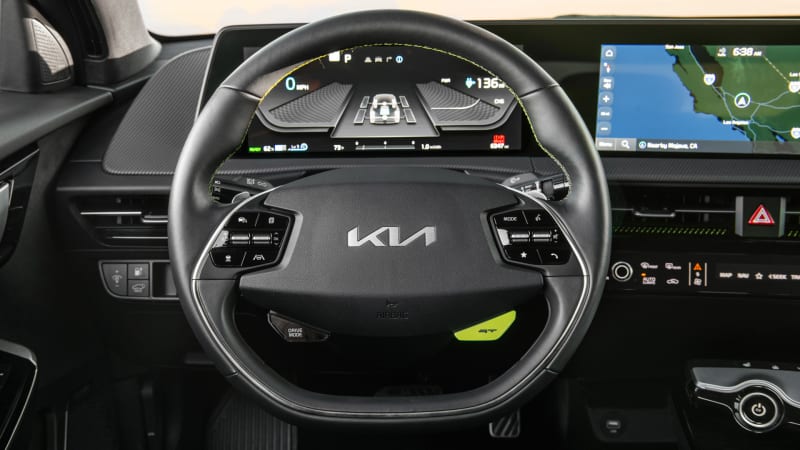
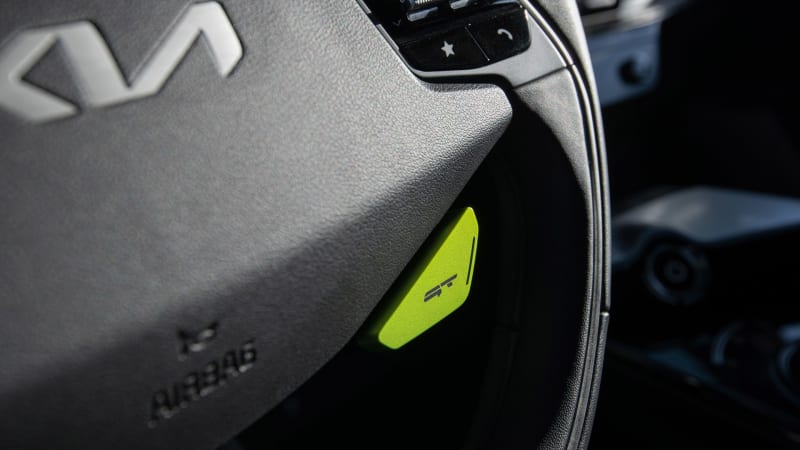
Now across the board, the GT rides firmer and has less body roll than the regular all-wheel-drive EV6s, but it’s only a little more so in Eco and Normal. Sport is a step further, and GT is downright stiff. The roads around Las Vegas are pretty darn smooth, so it was hard to notice, but the odd time the pavement got rough, it got bumpy enough that you’d likely be reaching for a comfier setting. Of course, you can mix and match settings in the custom mode, so you can, for example, get maximum power or tighter steering with softer suspension settings so compromises aren’t really necessary.
Make no mistake, though, from a performance perspective, the GT setting is the most exciting. All that power coupled with lightning-quick throttle response and even the most aggressive regenerative braking is highly entertaining. And those stiff suspension settings do in fact finally make the EV6 feel light and nimble, at least on public roads. It changes directions quickly and doesn’t feel like it’s heaving itself this way and that. It’s poised more like a Polestar 2. The rear-drive bias and lenient stability control also mean it likes to wiggle its backside. Other settings such as Sport have more active traction and stability control settings, and they keep the front/rear power split a little more even.
It can’t quite hide all that weight on a race track, though. We had some time on the short handling course outside the Las Vegas Motor Speedway, and even with the massive improvements in responsiveness, there’s no getting around that you need to be wary in corners with so much mass. But the chassis is quite communicative, and it’s easy to adjust its attitude in turns with the throttle, either by lifting off or pushing harder. And it is fun to sling the back end out, especially with the “hidden” drift mode that lets you thoroughly roast the tires and even spin out if that’s what it comes to. The sound of tire squealing and nothing else is pretty amusing, and it’s wonderful that EV makers are building cars that let you be silly.
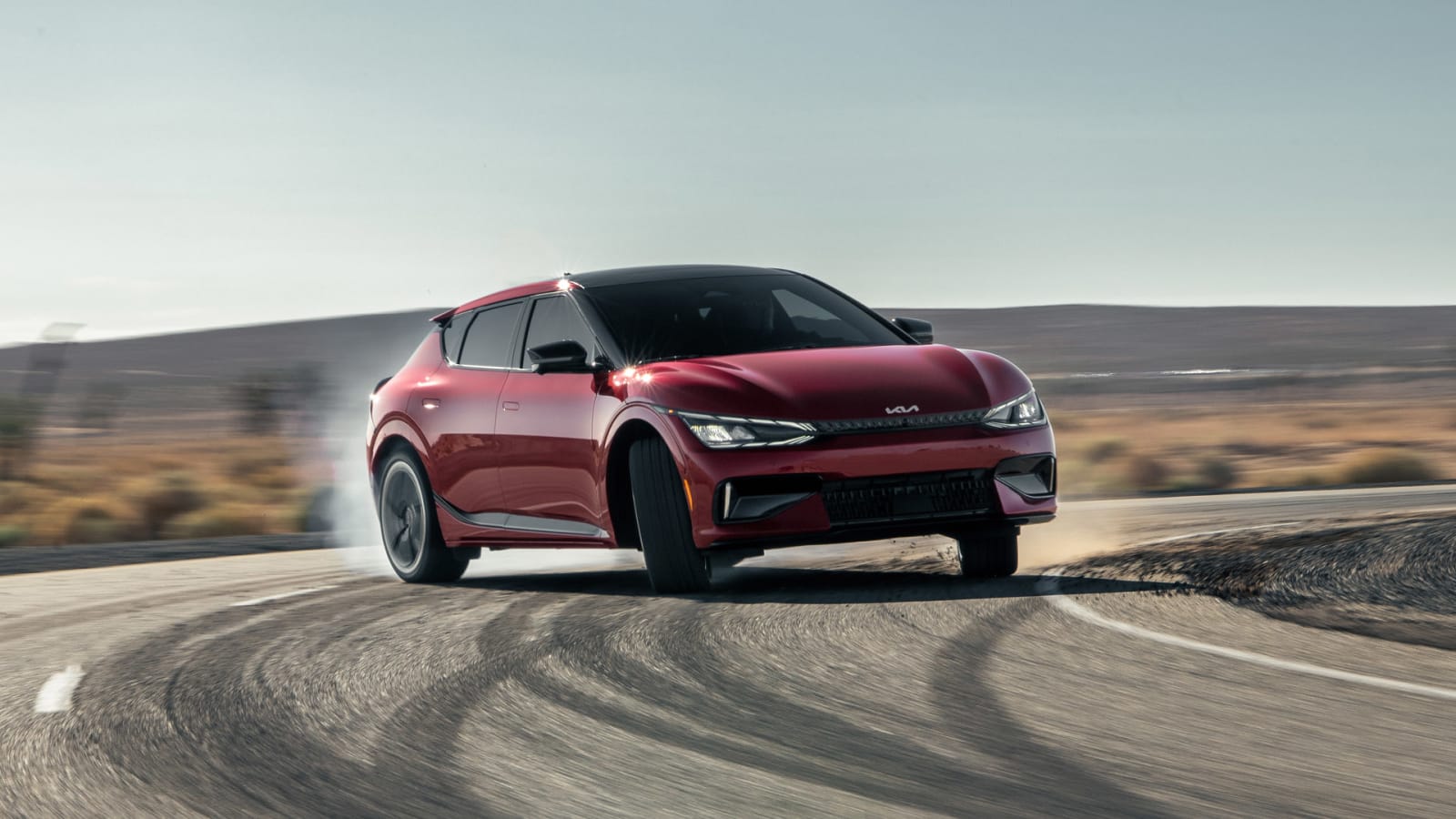
There are two things that could be a little better on the GT. First is the steering. It’s mighty numb and could be more precise. Initial turn-in could be sharper, too. And the brakes are a little soft and not always the easiest to modulate. They’re things you get used to, and the rest of the car is fun enough to forgive them, but it’s the fine-tuning of primary controls like this that often separate the most special and memorable performance cars from everything else. The GT just isn’t there.
OK, so there’s also a third thing. The EPA range for the EV6 GT isn’t great at 206 miles since it has the the same 77.4-kWh battery as its siblings despite all those extra horses. It’s no different than if a V8-powered model had the same gas tank size as a four-cylinder version. Fortunately, like its less powerful siblings, the GT still features 800-volt electrical architecture and the ability to take advantage of 350-kW fast chargers (unlike the Mustang Mach-E GT and many other EVs), and it can pre-condition its battery after a charging station is put into the navigation system in order to optimize charging speed upon arriving.
That’s a major advantage for the GT versus other high-powered EVs, but so too is its price, which starts at $62,695. The 480-hp Mach-E GT and approximately 450-hp Tesla Model Y Performance both start at around $70,000. The Polestar 2 with dual motors and the Performance package slides in below the $60,000 mark, but is still shy of the Kia’s outright output at 469 horsepower.
The Kia EV6 GT isn’t perfect, but it’s still a mighty fun machine. It’s by far the most exciting and playful vehicles on the E-GMP platform. That means that not only is it a blast, but it comes with all the inherent styling and EV goodness of that platform. With its value-packed price, you can’t afford to miss looking at one if you’re wanting some electric speed.

